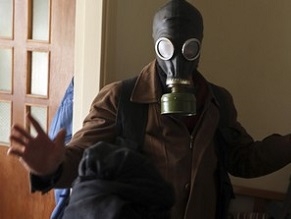|
World Jewish News

A fighter from the Free Syrian Army wears a gas mask in January 2013. Photo: REUTERS/Goran Tomasevic
|
'Assad has enough sarin to wipe out Damascus, Aleppo, Homs'
24.05.2013, Israel and the World The regime of President Bashar Assad had enough of nerve gas sarin to "eradicate the whole of Damascus, Homs, Hama and Aleppo," a former Syrian chemical weapons scientist told Al Jazeera on Friday.
"If the regime is to fire a Scud-B with a chemical warhead filled with sarin, the missile would create a chemical cloud in the atmosphere that is 3km long and 500m wide, which could be fatal to all people under it," the scientist, that asked to remain anonymous, said.
The scientist told Al Jazeera that Syria's chemical weapons stockpile includes 700 tons of sarin gas as well as mustard gas in unspecific quantity, at least 3,000 aerial bombs that could be fitted with chemical warheads and more than 100 chemical warheads for Scud missiles. He dispelled assessment by Western intelligence that Syria has tabun nerve gas.
Despite that, the scientist that fled Syria claimed the Assad regime will only unleash its chemical stockpiles if it "no longer cares about the world knowing."
He told Al Jazeera that the Assad regime used sarin gas in small quantities to stop rebel advances in four towns in the suburbs of Damascus, in Aleppo's Sheikj Maksoud district, in Idlib's Saraqeb town and in Homs' al-Khalidiyeh district.
"The intention was to incapacitate rebels and force them out of strategic areas, while keeping the deaths among their ranks limited," he said.
Despite that, he cast doubt on reports that sarin gas was used by the Assad regime in Khan al-Assal in Aleppo on March 19, saying the gas has no smell, while medics reported a disgusting smell at the attack site.
The scientist added that the Assad regime has experiment with mixing different gases in order to make it harder to identify chemical weapons use.
"When opposition activists report different kinds of symptoms resulting from the different gases, it becomes hard to believe them. Some opposition fighters report a burning sensation in the eyes, raising the question as to whether this was tear gas or nerve gas," he told Al Jazeera.
The scientist said plans to use chemical weapons against rebel forces were not formed before December 2012, after his supervisor was kidnapped by the Assad regime in order to find ways to stabilize sarin in small munitions like cannon shells.
The scientist formerly worked at the chemistry institute of the Center for Scientific Studies and Research (CSSR), Syria’s main agency for the development and enhancement of weaponry, that was reportedly hit by Israeli air raids in February.
He was told by the regime that the chemical weapons stockpile was amassed as self-defense against Israel. "It was our dogma that we were creating the equivalent of Israel’s nuclear weapons. Never were we told that the weapons could be used inside the country," he said.
According to the scientist, there are around 9,000 employees at CSSR, 6,000 of them working in rocket development and 300 in chemical weapons development. These scientists work with two secret army units, 451 and 452, that handle the chemical weapons and secure them.
The scientist also revealed infrastructure and equipment to produce sarin was provided to Syria by the former West Germany, and that Armenian specialists trained in the Soviet Union aided in the production of VX in the 1990s.
JPost.com
|
|
